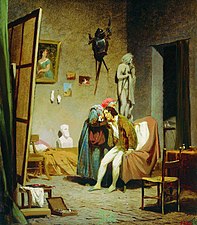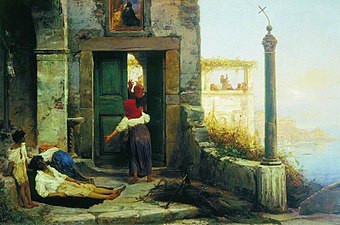| Fyodor Bronnikov | |
|---|---|
| Фёдор Бронников | |
 Self-portrait (1856) Self-portrait (1856) | |
| Born | 29 September [O.S. 17 September] 1827 Shadrinsk, Perm Governorate, Russian Empire |
| Died | 14 September 1902(1902-09-14) (aged 74) Anticoli Corrado, Rome Province, Italy |
| Education | Professor by rank (1864) |
| Alma mater | Imperial Academy of Arts |
| Occupation | Russian painter |
| Movement | Peredvizhniki |
| Awards | |
Fyodor Andreyevich Bronnikov (Russian: Фёдор Андреевич Бронников; 17 September 1827–14 September 1902) was a Russian-born history and genre painter who spent most of his life in Italy.
Biography
He displayed an early affinity for drawing and received his first art lessons from his father, who was a decorative painter. At the age of sixteen, when his father died, he packed his bags and went to Saint Petersburg, hoping to enter the Imperial Academy of Arts. After failing to gain admission, he became an apprentice in the workshop of Evstafy Bernardsky [ru], a well known woodcutter. His talent drew the attention of the sculptor Pyotr Clodt, who arranged for him to audit classes at the Academy. In 1850, he was able to become a regular student, and worked with Alexey Markov. He graduated in 1853 and was awarded a stipend to study in Italy for his graduation painting, The Mother of God.
The following year, he settled in Rome and established his own studio on Via Vittoria, near the Villa Borghese. He painted a wide variety of canvases, including landscapes, village scenes, genre scenes, historical works and, of course, portraits of the city's notable citizens. His health was poor, so he remained there after his stipend expired, to take advantage of the warm climate.
He paid a long visit home from 1863 to 1865. While there, the Academy awarded him a professorship in history painting for his depiction of Horace reading his satires to Gaius Maecenas. He also came into contact with a group of dissident artists who would later be known as the Peredvizhniki; which inspired him to paint a series of genre works on peasant life. Later, he became a member of the group and regularly sent paintings from Italy to show in their exhibitions. He was awarded the Order of St. Anna as well as being named an Academician and an honorary member of the Academy. During this period he created one of his best known works: The Cursed Field (1878), an indictment of slavery.
He died near Rome and was buried in the Protestant Cemetery. Despite having lived in Italy for most of his life, he left over 300 paintings and drawings and the equivalent of 400 Rubles to establish an art school in Shadrinsk. The school was not established until the Soviet period and the works were used as the basis for a museum.
Artistic method
A versatile artist Fyodor Bronnikov was a great master of portrait painting. His works of this genre, distinguished by a fine drawing, a striking resemblance to nature. Their peculiarity is also the psychological content of the portrait and the persuasiveness of the pictorial language. In the landscapes, the artist faithfully and penetratingly conveys a state of the world around. They are marked by colourful harmony and purity of colours. The artist developed his love for nature in his childhood years in the Trans-Urals. It is not by chance that in letters to his relatives in Shadrinsk he often recalls the beauty of his native places. "No boundless fields here as you have in Russia, no dense forests... and that's a pity. I love the vastness and our Russian fields, like a limitless sea," he shared his feelings with his countrymen.
Most of his works are in Russia, but many have also been acquired by amateurs from the UK, the US, Hungary, Italy, and Denmark.
Selected paintings
-
 The Sick Artist
The Sick Artist
-
 The Wayfarer
The Wayfarer
-
 Sick Man at the Walls of a Monastery
Sick Man at the Walls of a Monastery
-
 Pythagoreans Celebrate
Pythagoreans Celebrate
the Sunrise -
 The Cursed Field
The Cursed Field
(executed slaves) -
 The Rich Man and Lazarus
The Rich Man and Lazarus
References
- ^ Brief Biography from the Brockhaus and Efron Encyclopedic Dictionary @ Russian WikiSource.
- ^ Brief biography @ "Sunday Afternoon".
- "Лица Зауралья. БРОННИКОВ Фёдор Андреевич". Archived from the original on 2019-04-02. Retrieved 2021-09-17.
Further reading
- N. G. Vasileva, Фёдор Бронников, Biely Gorod, 2012 ISBN 5-7793-4082-X
External links
Categories:- Academic staff of the Imperial Academy of Arts
- Imperial Academy of Arts alumni
- Awarded with a large gold medal of the Academy of Arts
- 1827 births
- 1902 deaths
- People from Shadrinsk
- People from Shadrinsky Uyezd
- 19th-century painters from the Russian Empire
- Russian male painters
- Emigrants from the Russian Empire to Italy
- Russian history painters
- Russian genre painters
- Peredvizhniki
- Recipients of the Order of St. Anna, 3rd class
- Burials in the Protestant Cemetery, Rome